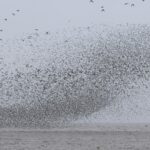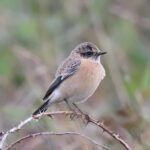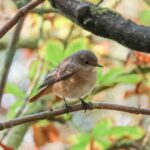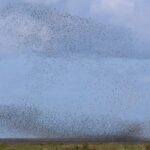A Private Tour today in North Norfolk. The brief was to avoid the main nature reserves on the coast. The forecast was for it to be “rather cloudy with outbreaks of light rain at first” according to the Met Office. How wrong it was! Instead, when we met up in the morning it was wall to wall blue sky and crisp sunshine. With weather like that, there was only one place to start the day.
As soon was got out of the car up on the Heath, we heard a Woodlark calling as it flew away. A dog was running across the cleared area nearby and had probably just flushed it. Still, it seemed an auspicious start. A Yellowhammer flew in and landed in the top of one of the bushes by the car park. A smart male, we got it in the scope and its yellow head was positively glowing in the morning light. Stunning!
 Yellowhammer – a smart male glowing yellow in the morning sun
Yellowhammer – a smart male glowing yellow in the morning sun
A couple more Yellowhammers dropped in to join it, another male and a duller female. While we were watching them, we heard the Woodlark calling again as it flew back in. We saw where it landed in the long grass and walked a little closer to where we could see it. Thankfully, it was standing up on a slightly taller tussock and it started to sing softly as it stood there. We got it in the scope and all had a good look at it.
When the Woodlark took off again, it flew straight towards us and gained height. Then it started singing as it came right overhead, hovering above us for a minute or so. The Woodlark‘s song is not full of the joys like a Skylark but slightly more melancholy. It is still a beautiful sound, a real delight to stand and listen to it on such a sunny morning, one of the real sounds of early spring on the heaths. As it hung overhead, we could see the Woodlark‘s comparatively short tail and broad rounded wings.
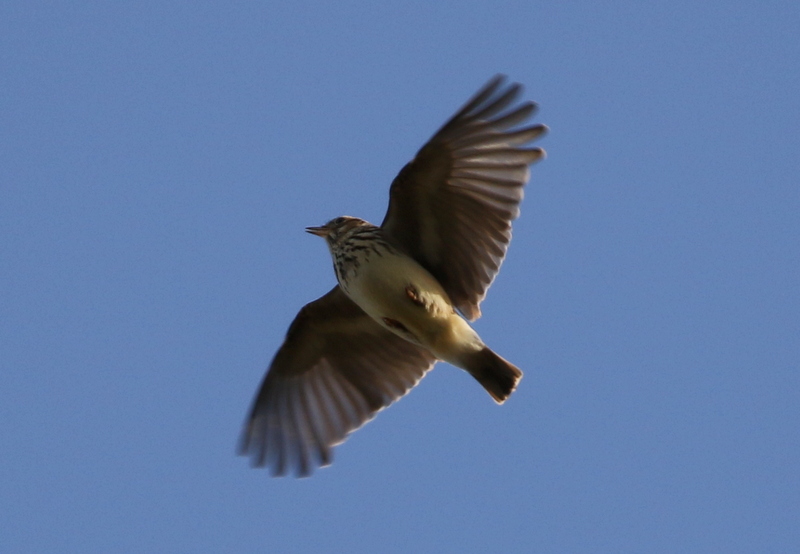 Woodlark – hovering over our heads this morning, singing
Woodlark – hovering over our heads this morning, singing
After a while, the Woodlark flew down and landed again at the back of the clearing. We were planning to be greedy and go over for another look at it, but we were distracted by another smart male Yellowhammer hopping around on the ground in front of us. While we were watching it, the Woodlark took off again, calling. A second Woodlark got up from the ground and followed it – clearly the male had been singing while the female was feeding quietly over the back of the clearing all along.
Sunny mornings on the Heath at this time of the year are a great time to look for Adders. Having emerged from hibernation, they like to bask in the sunshine and warm themselves. We walked round to an area where we can often find them, a slope angled towards the morning sun. Very quickly we spotted one close to the path, but despite the early hour of the morning it was surprisingly lively already and quickly slithered off into the undergrowth. As we walked round this quiet corner, we heard a Bullfinch calling and looked across to see a smart pink male picking at the buds in the top of a dense blackthorn thicket.
After such a successful start to the morning, we decided to turn our attention to Dartford Warblers next. They are resident on the heaths all year round, but harder to find when it is cloudy and cold. At this time of year, on sunny days, they are starting to sing again. Walking round through the centre of one of their regular territories, all seemed rather quiet at first. Then we heard a distinctive rasping call and looked across to see a small dark long-tailed bird dart across a clearing between two gorse bushes. Our first Dartford Warbler.
Repositioning ourselves to where it had flown, we could soon see the Dartford Warbler flitting between the gorse bushes. As we followed it, it soon became clear there were actually at least three Dartford Warblers in the same area. They can be hard birds to track, as they are constantly on the move, disappearing into the dense vegetation for periods and then, just when you think you have lost them, flying out again. Occasionally one would perch out in the open for a couple of seconds – we could see there was a male, darker slate blue grey above and richer burgundy below, a duller female, and a young bird, much browner above and paler below, one of the juveniles from last year.
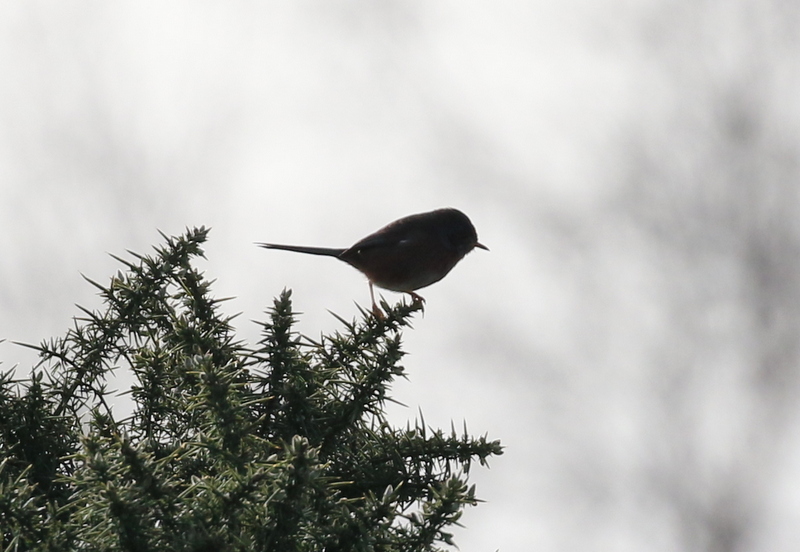 Dartford Warbler – the male singing from the top of a gorse bush
Dartford Warbler – the male singing from the top of a gorse bush
The male Dartford Warbler started singing. We could hear the bursts of scratchy song. At one point, we thought there might be two males, as we heard different bursts of song coming from different places in quick succession. After following them for a while, and having all enjoyed good views, we left them to it and continued our circuit of the Heath. As we walked round, were accompanied by the song of Woodlarks and Yellowhammers.
It was a perfect day for finding Adders today. We bumped into one of the local birders who is a regular on the Heath and he showed us three Adders basking round the base of a birch tree. A larger, darker female was stretched out on her own. Nearby, what looked like one snake turned out to be two curled up together as they moved – a large, dark female, and a smaller, slimmer, paler silvery male. A little further on, we found another two Adders, curled up in a couple of bare patches on a south facing bank. We had a great look at them.
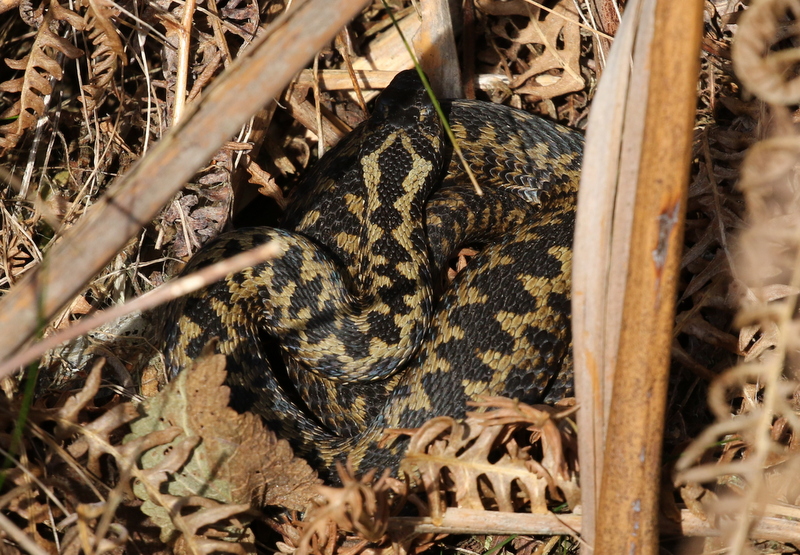 Adder – we found at least six out basking this morning in a brief look
Adder – we found at least six out basking this morning in a brief look
We had a quick look round another Dartford Warbler territory the other side of the Heath, but it was quieter here. There has been a pair of Stonechats here and the warblers have been following them round, but we couldn’t find any sign of either in their favourite area. Having enjoyed such a great session with the Dartford Warblers earlier, we weren’t overly concerned.
While we were walking round, another pair of Woodlarks flew over. The male landed on a post, where we could get him in the scope, while the female dropped down to the ground to feed. We were just watching them, when a third Woodlark started singing just behind us. These three were almostly certainly different to the pair we had seen earlier, which would mean potentially three pairs of Woodlark here this morning. It had been a great morning on the Heath and we could easily have stayed here all day, but we had other things we wanted to do today, so we made our way back to the car.
Our next destination was Holkham. As we drove down along Lady Anne’s Drive, we could see a large flock of geese on one of the grazing meadows nearby, so we stopped for a closer look. We could see they were mostly Brent Geese, smaller and darker, but nearby were a few grey-brown Pink-footed Geese too. A lot of the Pink-footed Geese which have spent the winter here have already departed on their way back north, so it was nice to be able to get a good look at some. We could see their delicate mostly dark bills with a pink band around and, when one stood up in the grass, its pink legs.
 Pink-footed Geese – a few were still by Lady Anne’s Drive today
Pink-footed Geese – a few were still by Lady Anne’s Drive today
The vast majority of the Brent Geese here during the winter are Dark-bellied Brent Geese which breed up in arctic Russia. Occasionally, we get one of the other subspecies of Brent Goose in with the flocks, perhaps a Black Brant from NE Siberia or Alaska. In the past, some of these Black Brants have paired up and subsequently bred with one of the Dark-bellied Brents to produce hybrid young. One of these hybrids is a regular here at Holkham and a careful scan through the Brent flock revealed it. Subtly darker bodied than the others, it has a better marked white collar and more obvious whiter flank patch then the others.
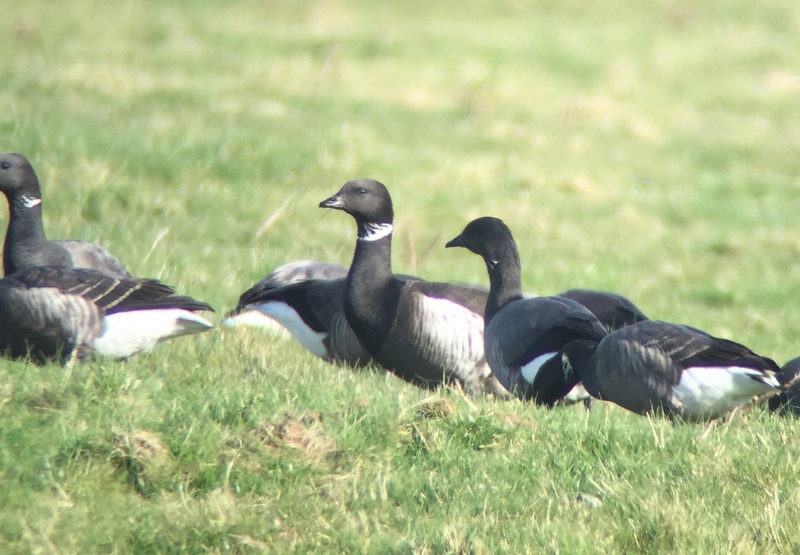 Black Brant hybrid – a regular in with the Dark-bellied Brents at Holkham
Black Brant hybrid – a regular in with the Dark-bellied Brents at Holkham
While we were watching the geese, we could hear Lapwings starting to display on the fields behind us, giving their distinctive song. There were also still some big flocks of Wigeon grazing close to the road, whistling occasionally. Several Common Buzzards were enjoying the sunshine, circling up into the blue sky and even starting to display, swooping up and down. It was getting on for lunchtime already, so we decided to have an early lunch here before setting off to explore.
After lunch, we walked out onto the beach and made our way east alone the edge of the saltmarsh. At first there was no sign of the large flock of Shorelarks which has been feeding here for the last few weeks. We were told they had earlier been flushed by an errant dog running around there. We walked across for a look at the sea, in the hope that they might return. The tide was in and there was not so much activity here today – a few Great Crested Grebes and a single drake Goldeneye were all we could find riding out on the slightly choppy sea.
There were three birders eating their lunch in the dunes nearby, looking out through their scopes at the saltmarsh, so we walked back round to see if they had seen anything. Very helpfully, they got us on to six Shorelarks which were feeding half hidden in the taller vegetation out in the middle. We were looking into the sun from here, so we walked back round to the other side.
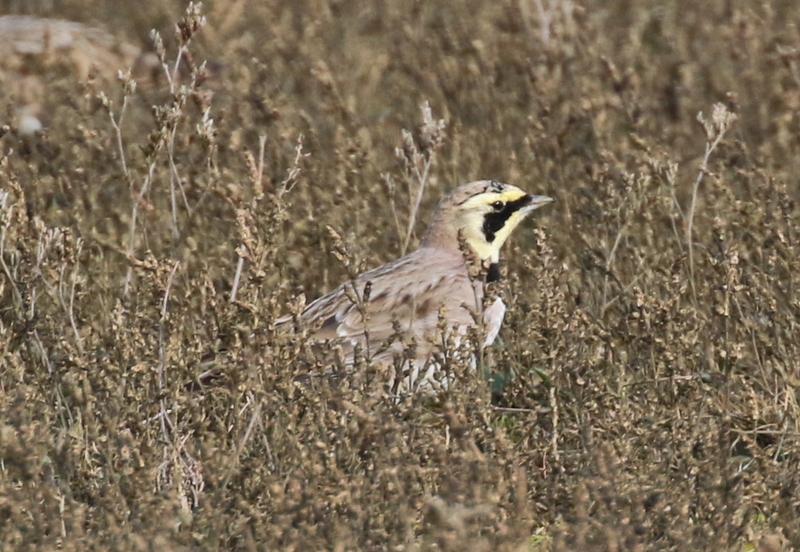 Shorelark – six were hiding in the taller vegetation on the saltmarsh
Shorelark – six were hiding in the taller vegetation on the saltmarsh
The Shorelarks were hard to see with their heads down while feeding, but occasionally one would look up and a bright yellow face would catch the sun. Then we could get a great look at them through the scope, admiring their black bandit masks and even occasionally get a glimpse of the black horns on the side of their heads. A Skylark was feeding nearby and a second flew in to join it, perhaps a male as it raised its crest and drew itself up erect, looking like it might be about to display to the first, before the two of them resumed feeding. As the Shorelarks gradually worked their way back deeper into the vegetation, we left them to it.
Back at :Lady Anne’s Drive, we made our way west along the path on the inland side of the pines. At this point it started to cloud over from the west. There were lots of Long-tailed Tits feeding high in the poplars as we passed. At Salts Hole, we stopped to watch a Little Grebe diving on the edge of the reeds. A couple of Mistle Thrush and a few Curlew were feeding on the grassy field beyond.
We had a quick scan from the raised boardwalk by Washington Hide. A Marsh Harrier circled up from the reeds. A Sparrowhawk flew past with something in its talons, trailing several long strands of grass with whatever prey it had grasped. Two Pintail flew in and landed on the pool, an adult drake with a long pin-shaped tail and a younger male without.
 Spoonbills – 2 of the 4 circling round over the trees
Spoonbills – 2 of the 4 circling round over the trees
As we approached Joe Jordan Hide, we got a glimpse through the trees of four white shapes taking off from the pool in front and through binoculars we could see they were Spoonbills. From up in the hide, we watched them circling round over the trees beyond, long white necks held outstretched in front. Eventually they landed again on the edge of the pool and started to preen before quickly going to sleep – which is what Spoonbills seem to like to do best! Two were adults and through the scope we could see their bushy nuchal crests flapping around in the breeze. When they did lift their heads we could see the yellow tips to their bills.
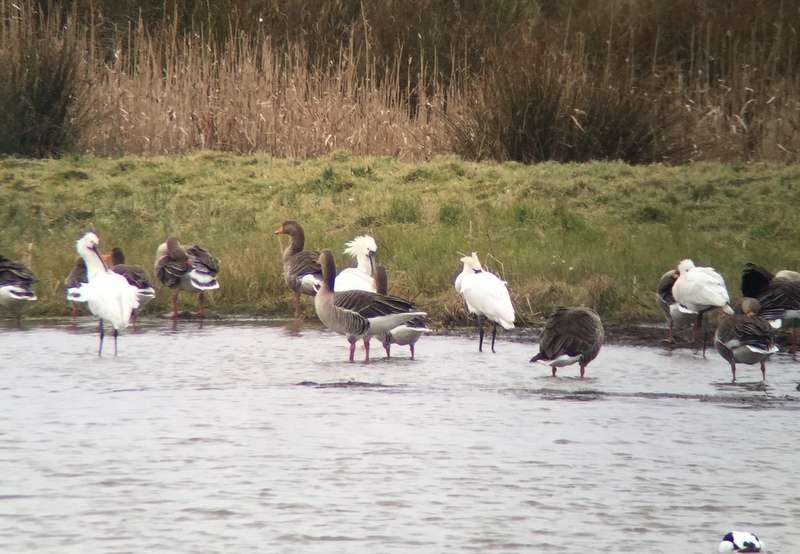 Spoonbills – the adults with bushy crests and yellow-tipped bills
Spoonbills – the adults with bushy crests and yellow-tipped bills
There were lost of geese out on the grazing marshes all around, mostly White-fronted Geese. They were hard to count, as they kept flying round in small groups and landing in different places or dropping down out of view. Sitting in the hide, we could hear their yelping calls every time a party flew past, a constant backdrop to our visit. There were several hundreds here today, more than there seem to have been through much of the winter, perhaps boosted by other groups stopping off before departing back to their breeding grounds in Russia.
We got some of the White-fronted Geese in the scope, so we could see the white surround to the bill from which they get their name, and the black belly bars on the adults. At one point, a small group landed next to some Greylags and we could see the White-fronted Geese were notably smaller and darker overall, as well as having a smaller pink bill compared to the large orange carrot sported by the Greylags.
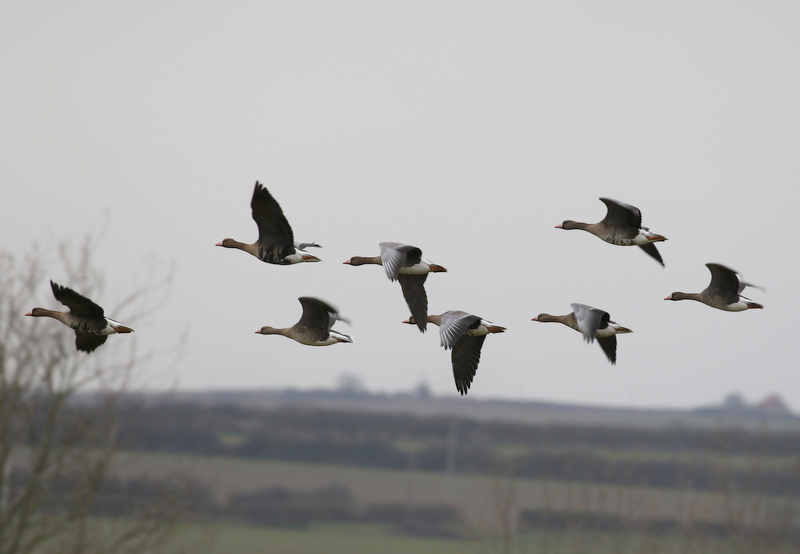 White-fronted Geese – their were large numbers at Holkham today
White-fronted Geese – their were large numbers at Holkham today
Scanning through the White-fronted Geese, we found a couple of smaller white-faced Barnacle Geese in with them. It would be nice to think that these also might be winter visitors from the arctic, but their status is complicated by feral populations, including in Holkham Park. There were also some Canada Geese here and several pairs of Egyptian Geese – a couple of more obviously feral geese species to round out the overall variety.
While we were looking through the geese, we noticed a large raptor flying low over the grassy ridge in the distance. It was clearly slimmer winged and tailed than the commoner Marsh Harriers and, as it turned, we could see a square white rump patch. It was a Hen Harrier, a ringtail. Unfortunately, it continued off away from us and it was not a great view, but a nice bird to see out hunting here nonetheless.
We had hoped we might see a Great White Egret here, but there was no sign at first. We were just thinking about leaving, when a large white shape walked out of some dense reeds on one side of the marshes. It was clearly huge, even with the naked eye, but through the scope we could see its long yellow bill. It was strutted across and went back into some deeper reeds, where it stood motionless fishing and it was surprisingly hard to see for such a large bird.
After a short while, the Great White Egret flew across and landed on the far side of one of the reedy ditches. Then a second Great White Egret flew out from nearby and chased after it, the two of them flying off together before eventually disappearing disappearing round behind the trees.
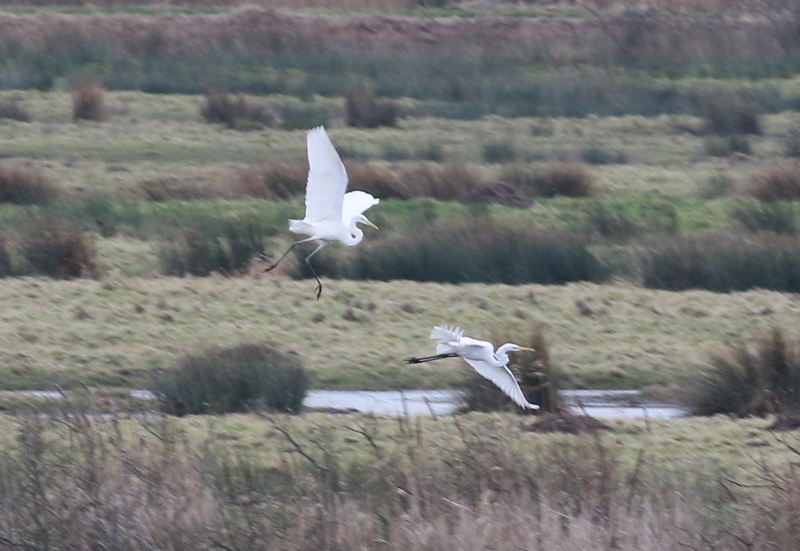 Great White Egret – a second flew in and chased off the first
Great White Egret – a second flew in and chased off the first
Time was getting on now, so we decided to head back to the car. We still had time for one more stop on our journey back, so we turned off the coast road at Stiffkey Greenway on our way back east. Scanning the saltmarsh, we first picked up a Marsh Harrier working its way slowly along the grassy ridge at the back. It didn’t take us long to pick up our first Hen Harrier, a ringtail, hanging over the saltmarsh away to the west. We got it in the scope and got a good view of it, much better than the one we had seen earlier at Holkham. Even better, it then drifted back east and started hunting the saltmarsh out in front of us.
 Hen Harrier – a ringtail hunting over the saltmarsh
Hen Harrier – a ringtail hunting over the saltmarsh
At one point, as it quartered the saltmarsh, the Hen Harrier flushed a Merlin from the bushes below. Small and dark, it flew off swiftly low over the vegetation. It looked like it would disappear into the distance, but thankfully it landed on a dead branch and started preening, so we could all get a look at it through the scope.
As we looked out over the marshes, another ringtail Hen Harrier made its way in purposefully from the east and across in front of us. We were really hoping to see a male Hen Harrier, but they kept us waiting a bit this evening. We did get an early glimpse of one, but it disappeared down into the vegetation very distantly to the west and didn’t reappear. Eventually one flew in from the west towards us, at the back of the saltmarsh. It flew past a male Marsh Harrier, giving a nice comparison of size and shape, the Hen Harrier a ghostly grey apparition. When it flew up against the grey sky, it almost disappeared.
After quartering the saltmarsh for a while, the male Hen Harrier dropped down into the vegetation at the back. We saw it fly up again briefly and we could just see its pale head in the grass occasionally, but it was clearly in no rush to fly again. It was a nice way to end the day, watching the harriers, so with the light fading we decided to head for home.
